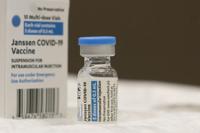WASHINGTON (AP) — U.S. health advisers endorsed a booster of Johnson & Johnson’s COVID-19 vaccine Friday, citing growing worry that Americans who got the single-dose shot aren’t as protected as those given two-dose brands.
Advisers to the Food and Drug Administration weighed J&J’s proposal for a flexible booster schedule. The company said the extra dose adds important protection as early as two months after initial vaccination, but that it might work better if people wait until six months later.
The FDA’s advisory panel voted unanimously that the booster should be offered at least two months after immunization but didn’t suggest a firm time. The advisers cited growing evidence that J&J recipients are more vulnerable to infection than people who got vaccines from competitors Pfizer or Moderna— and that most got their single dose many months ago.

The government says that all three U.S. vaccines continue to offer strong protection against hospitalization and death from COVID-19 and that the priority is getting first shots to the 66 million eligible but unvaccinated Americans who are most at risk. But J&J’s vaccine has consistently shown lower effectiveness across a series of studies while “breakthrough” infections become a bigger concern due to the extra-contagious delta variant of the coronavirus.
The FDA isn’t bound by the vote but its ultimate decision could help expand the nation’s booster campaign.
Adding another twist, the experts also discussed preliminary data from a government “mix-and-match” study that suggested J&J recipients may have a far stronger immune response if they get either a Moderna or Pfizer booster rather than a second J&J dose.
J&J’s single-shot vaccine is made with a different technology than the two-shot Pfizer and Moderna vaccines.
The vast majority of the 188 million Americans who are fully vaccinated against COVID-19 have received the Pfizer or Moderna options, while J&J recipients account for only about 15 million.
J&J presented results from a large study that found giving a second dose just two months after the first bumped protection against symptomatic COVID-19 to 94% from 70% in U.S. recipients. Giving that booster six months later instead prompted an even bigger jump in virus-fighting antibodies.
